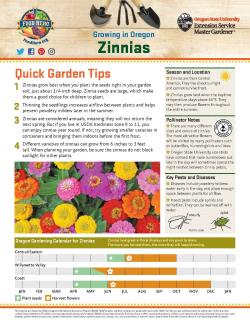Quick Garden Tips
- Zinnias grow best when you plant the seeds right in your garden soil, just about ¼-inch deep. Zinnia seeds are large, which make them a good choice for children to plant.
- Thinning the seedlings increases airflow between plants and helps prevent powdery mildew later in the summer.
- Zinnias are considered annuals, meaning they will not return the next spring. But if you live in USDA hardiness zone 9 to 11, you can enjoy zinnias year round. If not, try growing smaller varieties in containers and bringing them indoors before the first frost.
- Different varieties of zinnias can grow from 6 inches to 3 feet tall. When planning your garden, be sure the zinnias do not block sunlight for other plants.
Season and Location
- Zinnias are from Central America. They like direct sunlight and cannot survive frost.
- Zinnias grow best when the daytime temperature stays above 60°F. They may then produce flowers throughout the entire summer.
Pollinator Notes
- There are many different sizes and colors of zinnias. The most attractive flowers will be visited by many pollinators such as butterflies, hummingbirds and bees.
- Oregon State University scientists have noticed that male bumblebees out late in the day will sometimes spend the night nestled between zinnia petals.
Key Pests and Diseases
- Diseases include powdery mildew: water early in the day, and allow enough space between plants for airflow.
- Insect pests include aphids and whiteflies. They can be washed off with water.
When to Plant and Harvest Zinnias in Oregon
- Central and Eastern: Plant seeds indoors in June to harvest July through September.
- Willamette Valley: Plant seeds indoors late April through May to harvest May through September.
- Coast: Plant seeds indoors April through May to harvest June through November.




